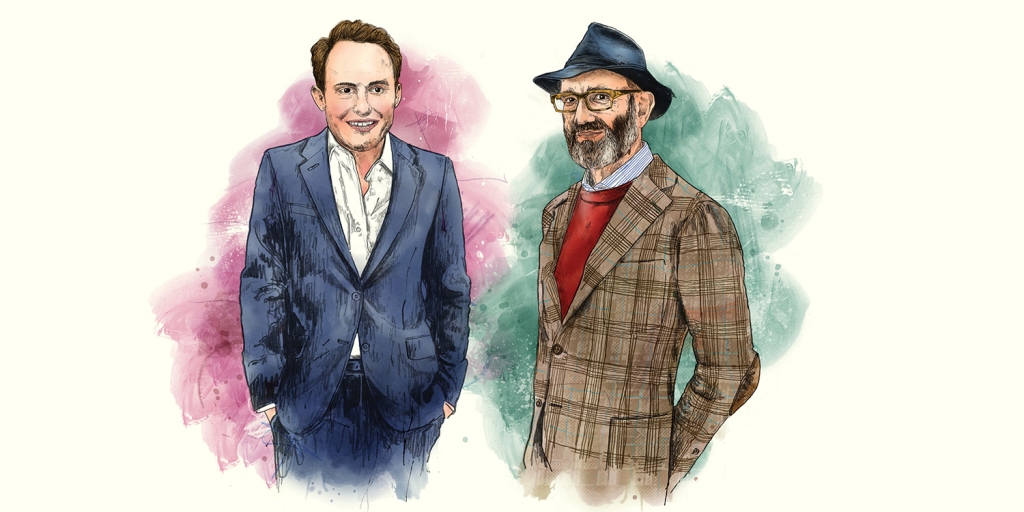 Scott Rothkopt, left, and Carlos Basualdo.
Scott Rothkopt, left, and Carlos Basualdo.
Scott Rothkopf is senior deputy director and chief curator at the Whitney Museum of American Art, where he has worked since 2009. Among his many credits are exhibitions of work by Laura Owens, Jeff Koons, Wade Guyton, and Glenn Ligon, as well as “America Is Hard to See,” the inaugural show at the museum’s new home in 2015 that featured the Whitney’s permanent collection.
Born in Argentina, Carlos Basualdo has been curator of contemporary art at the Philadelphia Museum of Art since 2005. Among his high-profile exhibitions is “Dancing Around the Bride: Cage, Cunningham, Johns, Rauschenberg, and Duchamp,” a 2012 survey of the influence of Marcel Duchamp on John Cage, Merce Cunningham, Robert Rauschenberg, and Jasper Johns.
Together, Rothkopf and Basualdo have spent more than five years in close collaboration on one of this year’s most eagerly anticipated exhibitions: “Jasper Johns: Mind/Mirror,” which opens next week simultaneously at the Whitney and the Philadelphia Museum. An unprecedented alliance between the institutions, the retrospective was conceived as a single presentation that is two shows at once coalescing around ideas related to Johns’s career-long interest in mirroring and duplication; appropriately, the artworks appear in thematically arranged galleries that reflect each other across the museums.
Rothkopf and Basualdo joined ARTnews this past May to discuss their collaboration on an exhibition unlike any either had undertaken before.
 Jasper Johns’s Racing Thoughts, from 1983, is in the collection of the Whitney Museum of American Art. Whitney Museum of American Art/©2021 Jasper Johns/Licensed by VAGA at Artists Rights Society (ARS), New York
Jasper Johns’s Racing Thoughts, from 1983, is in the collection of the Whitney Museum of American Art. Whitney Museum of American Art/©2021 Jasper Johns/Licensed by VAGA at Artists Rights Society (ARS), New York
ARTnews: What is your first memory of recognizing the act of curation in a way that put you on your career path?
Carlos Basualdo: When I was in Argentina, I was mostly writing poetry. I was part of a group of people, with musicians and visual artists, and there were vivid conversations at the time across multiple disciplines. I was interested in what an exhibition could do as a medium for combining ideas, different from though related to poetry. For me, from the very beginning, exhibitions were a way to think about creating a sort of extension of what I was trying to do with my work as a poet.
Scott Rothkopf: My answer is a bit cornier. I grew up adoring, from the age of seven or eight, being around works of visual art. I didn’t have access to them in collectors’ homes or commercial galleries. I dragged my family to museums in any town we ever landed in, but I didn’t have an idea that there was a profession called “curator” that was responsible for selecting and displaying artworks. I sensed that museums were places where I might want to work in the future, and by the time I arrived at college and started to study art history, a light bulb went off over my head—like, Oh, there’s this job of being a curator, and they are the ones who do neat things at museums. It kind of went from there.
[7 Works to Know by Jasper Johns]
ARTnews: How did the two of you first meet?
Basualdo: My wife was doing a post-doctorate at Harvard and introduced me to Scott. He was a student of Yve-Alain Bois, and I was using the fine arts library to prepare my course on the history of exhibitions in Venice.
Rothkopf: Carlos and I didn’t know each other that well prior to this project—besides the little bit from when we met—but I have a profound memory of his show “Dancing Around the Bride: Cage, Cunningham, Johns, Rauschenberg, and Duchamp.” I made pilgrimages to Philadelphia for it, and it remains one of the most amazing exhibitions I have ever seen. I was very happy to work with someone who curated something I respected so much.
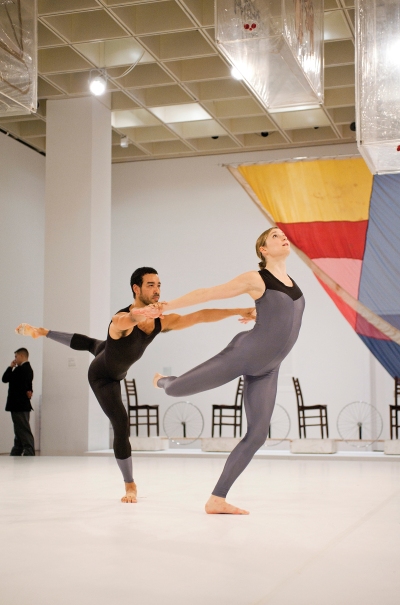 “Dancing Around the Bride,” the 2012 show curated by Carlos Basualdo featured performances of works by choreographer Merce Cunningham. Courtesy Philadelphia Museum of Art
“Dancing Around the Bride,” the 2012 show curated by Carlos Basualdo featured performances of works by choreographer Merce Cunningham. Courtesy Philadelphia Museum of Art
ARTnews: Do you remember the first conversation you had about collaborating on an exhibition, going back to the beginning?
Basualdo: I totally do. The beauty of this project is that it didn’t begin as part of a big institutional machine but just the two of us speaking together and saying we both love Jasper and his work. I told Scott he’d written beautifully on Jasper’s work [in Jasper Johns: Catenary, an exhibition catalogue published by Matthew Marks gallery in 2005], and said, “Wouldn’t it be great to think of a show together?” It really started from us, as curators.
Rothkopf: We spoke about wanting to do something together, and it was slightly later that you mentioned your idea that the show could happen simultaneously. It wasn’t instantly something I could appreciate or understand because it was so unusual. I was thinking an exhibition would make sense for both our institutions—but how would it work, because we’re not going to get loans for long enough, or the museums are too close to make sense for it to tour from one to the other. I give Carlos credit for saying, “Well, what if we tried it this other way?”
ARTnews: Scott, you mentioned “Dancing Around the Bride.” What was most distinctive about that show for you?
Rothkopf: I loved the sense of surprise and interdisciplinarity and joy that Carlos brought to life in the conversation among the different artists in relation to Duchamp. I also loved the idea of having a stage in the center of the show where dance could be performed and music could be heard—not in a video setting, as is generally the case in such shows. It conjured the dialogue and the dynamic between these people in a way that felt so fresh and present. I will never forget that.
ARTnews: Was it challenging to convince each of your respective institutions to present an exhibition of the sort you proposed?
Rothkopf: The Whitney is really open to experimental ways of working—it’s part of our DNA. If I could convince them to get Jeff Koons’s Play-Doh in through a small door, this show didn’t seem wildly improbable or impossible to pull off. It has been a tremendous challenge logistically and financially, but there’s been a spirit of openness and adventure on the part of our teams that has gotten us through. We’ve had to ask people to work in different ways together, everything from a shared lender who has works leaving their home and going to two different cities to smaller things like how do we not get in each other’s way when Google serves someone an advertisement in France, so that they’re not confused about where the show even is? Will our members get to go to one another’s museum for free? There are so many interesting and challenging institutional questions that cascade from the idea for the show. It hasn’t been easy for our colleagues to do their normal work in this kind of complicated situation, let alone during a pandemic. But we found a real spirit of coming together.
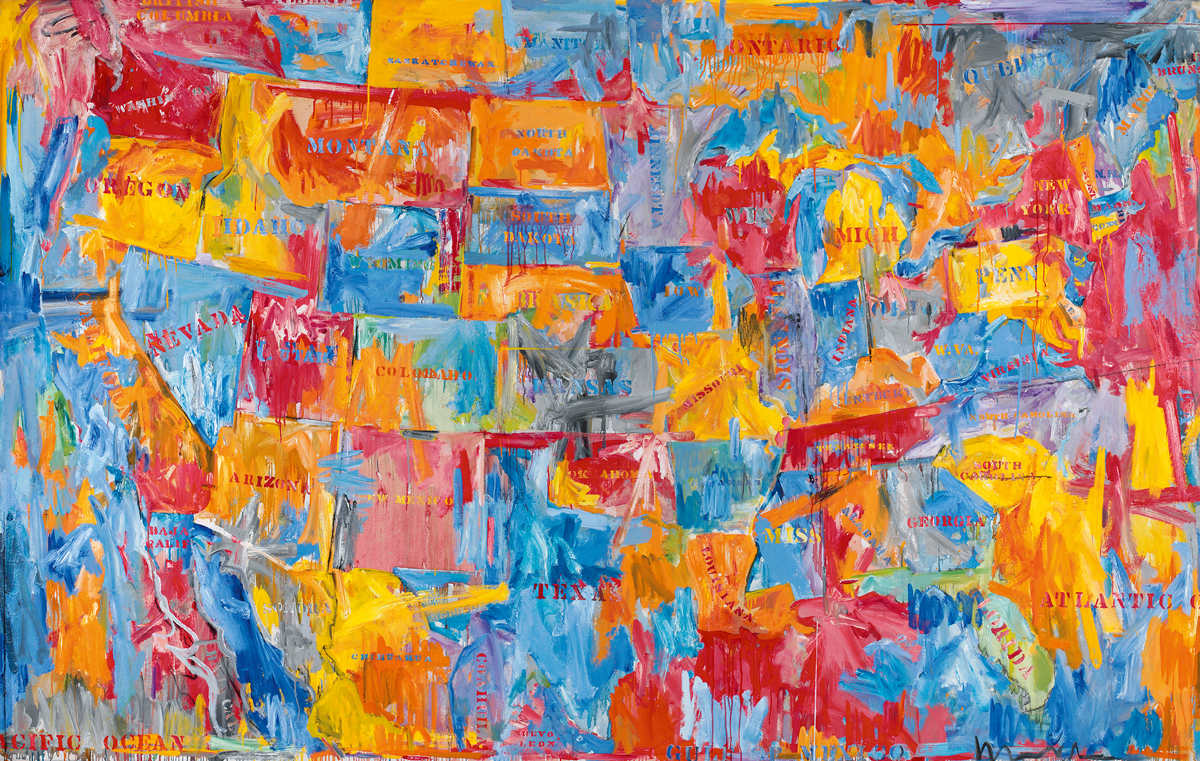 Jasper Johns’s 1961 painting Map features in “Jasper Johns: Mind/Mirror.”
Jasper Johns’s 1961 painting Map features in “Jasper Johns: Mind/Mirror.”
ARTnews: Carlos, how would you describe the persuading process in Philadelphia?
Basualdo: I felt at first like they were a little bit startled, but after that, they’ve been troopers overall. What is most interesting to me is the shape and form the show took, which came from a desire to address the logic of Jasper’s work—whatever that may be. There are a lot of things that came as a consequence of that, and one of them is the idea of one thing in two different places. We’ve been asked if there have been other shows like it…
Rothkopf: You curated one for Bruce Nauman in Venice [“Bruce Nauman: Topological Gardens,” presented in three different locations].
Basualdo: But this is different because Venice is one city and this is two. This is not one show that travels; it is not one show in two parts. This is one show that is two shows at the same time. Something at this scale doesn’t seem to have been attempted, and that can make people anxious and confused. But there has been a lot of enthusiasm as well.
Rothkopf: And let’s be clear: collaborating doesn’t always make things easier! It made it harder because of the incredible conceptual and logistical complexity around the project.
ARTnews: What was Jasper’s initial reaction to the idea of simultaneous shows?
Rothkopf: He said, “It sounds interesting—but hard to do.” Like, good luck to you—call me later if you can pull it off! [Laughs.]
Basualdo: He has always said that. When I explained the Nauman show to him, he said, “Oh, that would be great if you can pull it off.” And then for “Dancing Around the Bride,” he said, “Oh, that would be great if you can pull it off.” With this show he said the same.
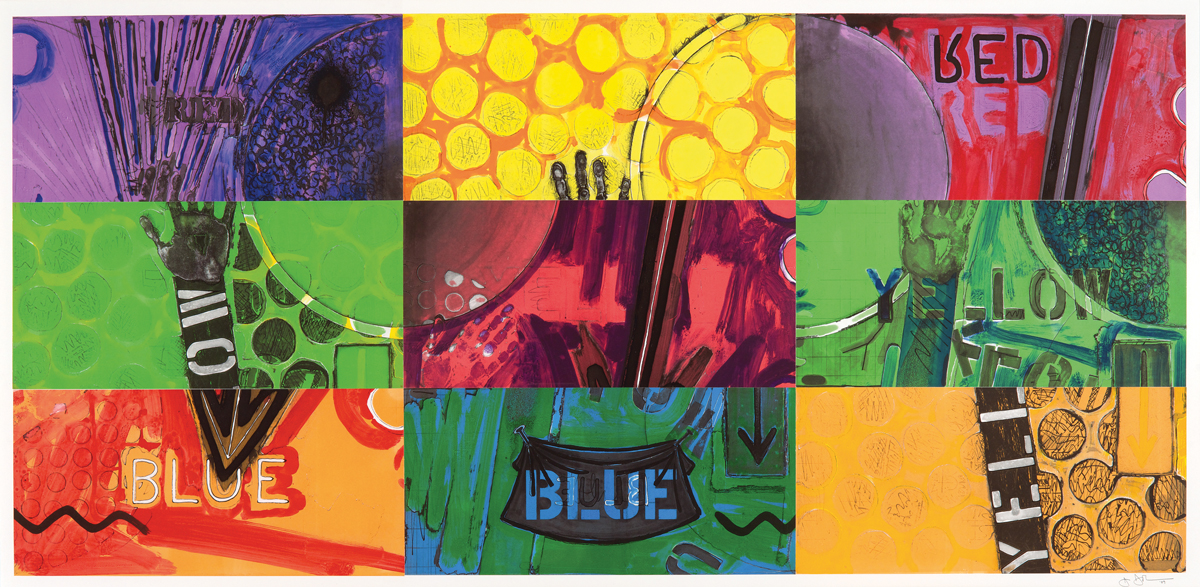 Jasper Johns’s Untitled, from 2014, counts among many works from the artist’s own collection featuring in “Jasper Johns: Mind/Mirror.” Collection of the artist/©2021 Jasper Johns/Licensed by VAGA at Artists Rights Society (ARS), New York
Jasper Johns’s Untitled, from 2014, counts among many works from the artist’s own collection featuring in “Jasper Johns: Mind/Mirror.” Collection of the artist/©2021 Jasper Johns/Licensed by VAGA at Artists Rights Society (ARS), New York
ARTnews: How did the two of you communicate with one another at the start?
Rothkopf: We had quite a lot of phone calls and a lot of texts. We visited one another and looked at work in our museums’ collections. We shook hands on the project in early 2016, and we didn’t know what Zoom was in those prehistoric years. We did a lot of traveling. I maybe did a bit more than Carlos, especially to see things in Europe. I went to the Ludwig Museum [in Cologne]. I went to see a painting in Stockholm.
Basualdo: I traveled more to New York than he did to Philadelphia.
Rothkopf: That’s true—it was not symmetrical. He was more frequently here, though we had a big kickoff meeting weekend in Philadelphia.
Basualdo: And we had many, many visits with Jasper in Sharon, Connecticut.
Rothkopf: We had a great rhythm there where we would get to go to Jasper’s storage gallery—The Barn, as they call it—and look at work together. We would often have lunch with him and talk about what we had seen or ask him questions. Then we would go back and work together. It was very fruitful to be around him and the work in this very beautiful, contemplative place.
ARTnews: What’s for lunch at Jasper’s house?
Basualdo: Beautiful lunches—very simple and frugal, but delicious.
Rothkopf: Very delicious things—it depends what’s in the market.
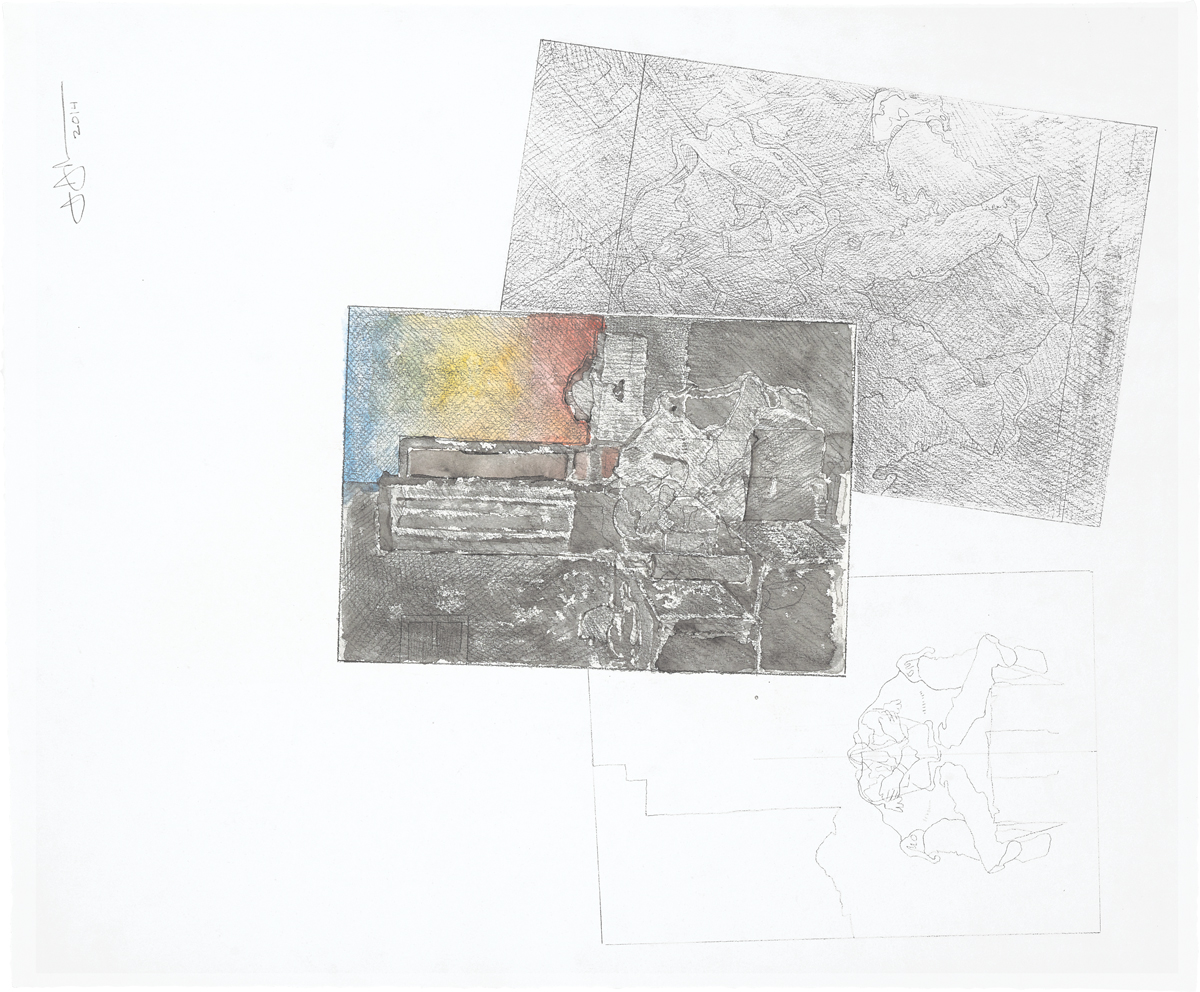 Another Untitled Jasper Johns work, from 2014, from Johns’s own holdings. Collection of the artist/©2021 Jasper Johns/Licensed by VAGA at Artists Rights Society (ARS), New York
Another Untitled Jasper Johns work, from 2014, from Johns’s own holdings. Collection of the artist/©2021 Jasper Johns/Licensed by VAGA at Artists Rights Society (ARS), New York
ARTnews: How would you describe his involvement as the show took shape? Where is he on the spectrum of artists who are either hands-on or hands-off?
Basualdo: He has been incredibly supportive. He is the largest lender to the show in terms of number of works [from Johns’s own collection], and when we went to Sharon and looked at works in person, that required deep involvement from all his staff. But he was also very willing to let us come up with our ideas. We explained to him the idea of mirroring for the show, and he was very generous in allowing us to do our work. When he needed to say something, he would. For two rooms with early motifs, Scott is showing flags and maps and I’m showing numbers; there was one particular work that he asked, “Do you have that in there?” That is how it would happen. He would be very open-minded and allow us a lot of freedom, and when he had something to say, he would—very directly.
Rothkopf: The instances of his saying he would like a specific work in a show of more than 500 works could be counted on one hand. He was not directional. I really think he deserves deep respect for his separation of church and state—between the work of the artist and that of the curator. He makes his work; we make the show. For me that was very different than any of the artists I’ve worked with on a retrospective, whether it was Jeff Koons, Laura Owens, Wade Guyton, Glenn Ligon—any of them. They were all incredibly involved in the selection of works and the framing of arguments. With Jasper, we haven’t always agreed at every stage of the journey, but it was almost unnerving for me at different points to be working with a living artist who gave us so much freedom.
ARTnews: A lot of the works that Jasper loaned to the show have never before been publicly shown. How would you characterize those works and how they made you think differently about his work overall?
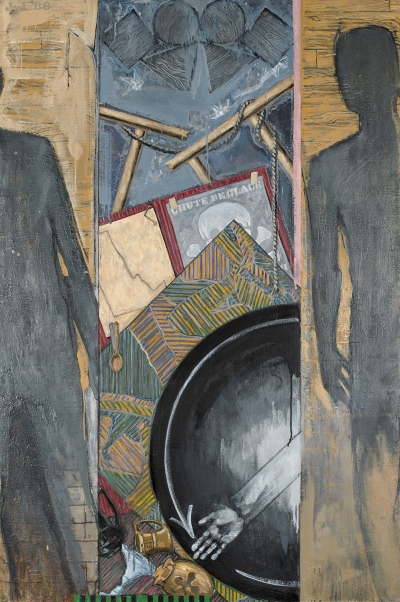 Jasper Johns’s Fall, from 1986, from the artist’s collection. Collection of the artist/©2021 Jasper Johns/Licensed by VAGA at Artists Rights Society (ARS), New York
Jasper Johns’s Fall, from 1986, from the artist’s collection. Collection of the artist/©2021 Jasper Johns/Licensed by VAGA at Artists Rights Society (ARS), New York
Basualdo: The drawings for us were a revelation. They point in so many directions. Another revelation was looking at his working proofs. Those are really interesting because Jasper started to sign and keep his archival prints. Many artists destroy those, and just keep a record of all the different steps. But Jasper keeps them and signs them, so the status of those archival prints is interesting in itself. Are they finished works? He allowed us to use them in the show, and they are truly extraordinary. You see him going in so many completely radical directions. His use of color and what he does with different techniques is just amazing. We were in the studio last week and there is an entire new body of work that sprang out from one painting in one year that is completely different, in some ways, to what he was doing before. He is a constant surprise.
Rothkopf: The notion of surprise made me realize that the image of Jasper Johns in the mind of art history—and a lot of viewers—is very smoothed-out and reductive. We tend to talk about a handful of works he made in the first five to 10 years of what has been a remarkably protean 65-year career—more so than almost any other artist who has lived as long in the public eye. We were talking about Ellsworth Kelly or Alex Katz, who have made great work all through their lives into their 90s—but any sample that you might take of their work in any decade would feel maybe more akin to something that came before or after. With Jasper, you have to allow yourself to see the incredible weird unpredictability. If you had a martian from outer space and showed them one of his flags, a crosshatch painting, and a recent skeleton painting, and asked if they were by the same artist, the martian would say, “Of course not!” There are many recursive aspects to Jasper’s work, with motifs and working questions and formal games—whether it’s about black and white, color, mirroring, or doubling. But there are also so many twists and byways in the iconography and the risks associated with the work. You have to let yourself see that and allow the strangeness to emerge in all its fullness. It’s a wild thing to behold and get your head around.
Basualdo: He has a protean imagination, and there is something about this show that is trying to look for the hidden laws that organize the process. Replication, repetition, the way he works with chronology—all of it is part of this syntaxis of an extraordinary visual construction. The show is trying to see if we can describe the laws that seem to organize this amazing, generous, and multiform production.
ARTnews: With so many artworks in the mix, how did you decide on what to include and what to leave out?
Rothkopf: Those conversations evolved in tandem. We didn’t make a checklist and then divide it up. We came up with a set of ideas that grew out of the work for 10 or so galleries that would exist in both places. At some point, as we were struggling to determine how to make sense of this simultaneity and yet this division—the idea of a fragment of a whole—we were looking for a structural metaphor or armature, as opposed to dividing the show according to “early and late” or by medium. The notion of the mirror, or the double, came to us through intense study of Jasper’s work as itself a kind of organizing principle. We have 10 basic ideas or concepts that the show explores, each of which is articulated by a different set of examples at each museum. It was this tremendous puzzle to find the works that would best articulate those thoughts. And what’s interesting is that some of Jasper’s most well-known and recognizable works did not end up in our show. Some people will think that’s because we couldn’t get a loan or something, but it was because we didn’t ask for them. We were not starting with a list of greatest hits. We started with a set of ideas that grew out of the work, and once those ideas took root, we edited and selected work to articulate them as clearly and fulsomely as we could.
 Jasper Johns’s Untitled, from 2014, counts among many works from the artist’s own collection featuring in “Jasper Johns: Mind/Mirror.” Collection of the artist/©2021 Jasper Johns/Licensed by VAGA at Artists Rights Society (ARS), New York
Jasper Johns’s Untitled, from 2014, counts among many works from the artist’s own collection featuring in “Jasper Johns: Mind/Mirror.” Collection of the artist/©2021 Jasper Johns/Licensed by VAGA at Artists Rights Society (ARS), New York
ARTnews: The show was supposed to open last October. Where were you in terms of the process when the world locked down before that in March?
Rothkopf: We were pretty done! We had the deeds for cranes to take paintings out of windows on Park Avenue. We had to evolve the conversation with lenders and everything else in so many complicated ways. It added a lot of complexity to an already complex situation.
Basualdo: It was very weird. We were going at full speed and then had to stop. There was a lot of time that we spent trying to understand how long we would need to wait. Could we open in six months? Ultimately, we decided that it was better to postpone the show for almost an entire year, but that wasn’t an immediate decision.
Rothkopf: We had an interim idea that we would postpone it until halfway through the year, then all the way. We could’ve tried to open this summer. We had a sense that the further we pushed it, the more recovered the world would be—but we also might lose momentum with an artist who is 91, and with lenders who were ready to be a part of the show. It was a balance between pushing it as far as we could to try to get to the other side of the pandemic and not pushing so far that we lost the plot.
Basualdo: We were also thinking about how the show was originally going to open a couple weeks before the presidential election. We didn’t know exactly where the country would be after it.
ARTnews: Are there aspects of the show that changed after the election?
Rothkopf: No. There will be a gallery at the Whitney with a kind of face-off between flags and maps that I imagined could have been seen along the lines of political party or race—between those who have an optimistic feeling about this country and those who see it as a pessimistic and menacing nation—that would have felt particularly high-key depending on the election. On the other hand, these works have survived many moments of conflict. They were made in the midst of the Cold War and the Vietnam War and the heights of the Civil Rights movement. Things have come and gone. When you are talking about a career as long as Jasper’s and the idea of staying power, it’s hard to be too on-the-nose with whatever the climate is around you. People might wonder: why Jasper now? Why not 10 years ago, or 20 or 30 years from now? You have to accept the idea that the work will find its audience and speak to people as it does with whatever is going on.
Basualdo: But it’s interesting how many things that we thought through took on different gravitas. In Philadelphia there will be a room of the recent drawings and paintings with skeletons and skulls. He has been using skulls for a long time, but they truly have proliferated widely in the recent work. Scott said he had a meeting with some of his staff and they were wondering if that is a reference to the pandemic. We don’t think it was. They were done before it. But they could be read as a reference to the pandemic now. These have been such incredibly tragic times, and Jasper is an artist who has dealt himself with tragedy on so many levels. So, there’s gravitas there for sure.
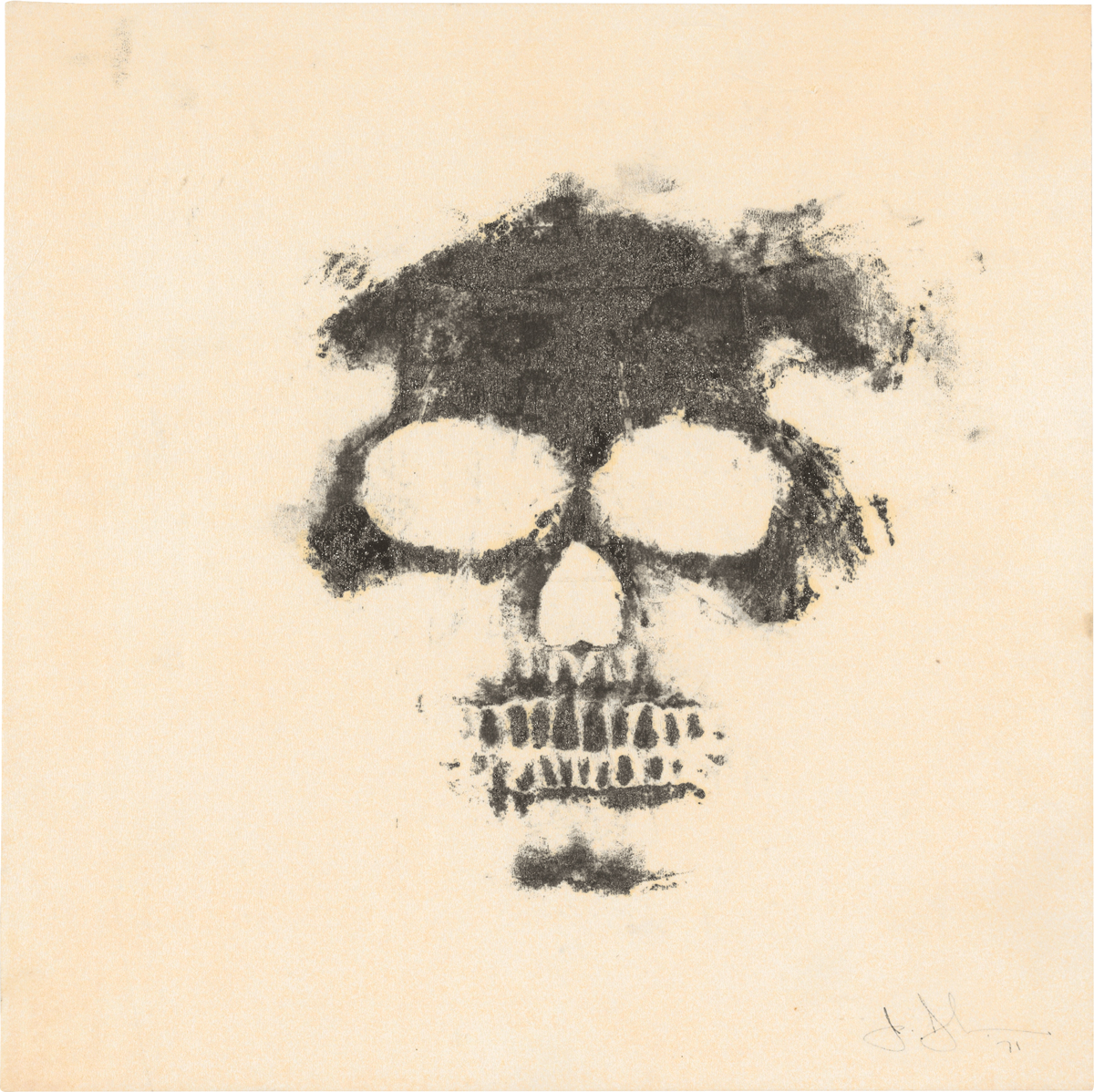 Jasper Johns’s Skull, from 1971, from the artist’s collection. Collection of the artist/©2021 Jasper Johns/Licensed by VAGA at Artists Rights Society (ARS), New York
Jasper Johns’s Skull, from 1971, from the artist’s collection. Collection of the artist/©2021 Jasper Johns/Licensed by VAGA at Artists Rights Society (ARS), New York
ARTnews: How is the exhibition different—or distinct—as a result of your having worked on it as a collaboration in the particular way you did?
Basualdo: The show is much better because it was done by the two of us. I have to say it is kind of excruciating to work so closely together, but at the same time it was amazing because I learned so much. We look at things in the same way but also have some completely different attitudes toward the work. I truly felt it was enriching at every step. I like the idea that the show is one and two, and the curators are one and two. I think it’s important in terms of work that deals with fragments and wholes and the tension between multiplicity and singularity. It makes sense.
Rothkopf: A lot of shows have curatorial teams, obviously, or curators at different institutions collaborating on something that goes to two places. But I don’t think anyone would have conceived an exhibition with a structure like this on their own. It is inherently different from anything one person or one institution would have done because of its entwined structure. It truly is a singular result of institutions joining hands and taking on an experiment. Our collaboration was at times like a game: we would take the lead on galleries—not for our own museum—and then hand them off. In each museum there are galleries that originated with one of us and then the other edited it and vice-versa.
Carlos and I also have different kinds of mind. I am somewhat a maniac for details, and I thank him for putting up with me and my very controlling tendencies. But I also learned from him a kind of openness that comes from the poetic background that Carlos cited around the start of his career. I learned about finding poetry and letting chance show us things, or leaving things open to the viewer or to the kind of strange alchemy between the work and the situation. These were lessons that we shared throughout the process. It could be tough at times, but in the end it made for a better show—something so different than either one of us could’ve ever imagined on our own.
A version of this article appears in the August/September 2021 issue of ARTnews, under the title “It Takes Two.”
Source link : https://www.artnews.com/art-news/news/scott-rothkopf-carlos-basualdo-jasper-johns-curators-conversation-1234604357












